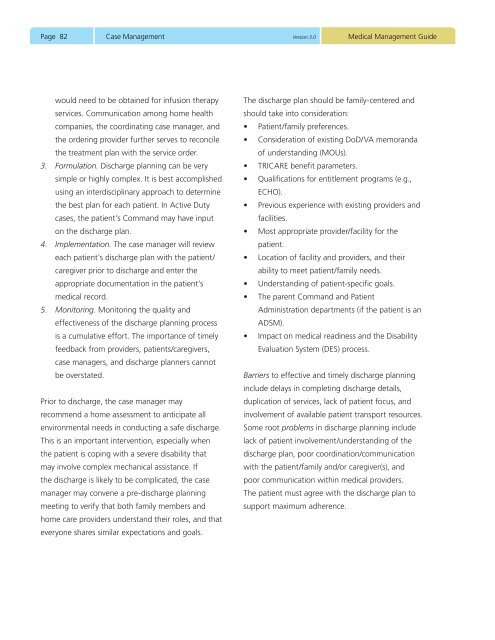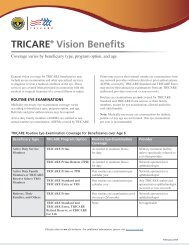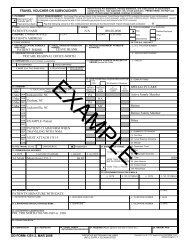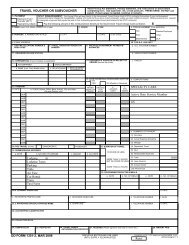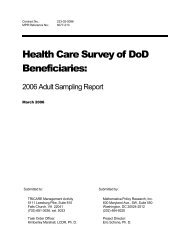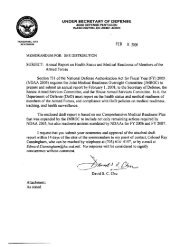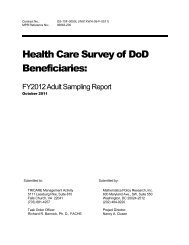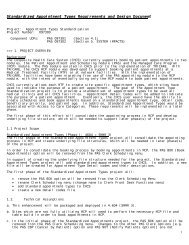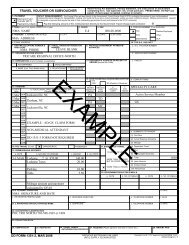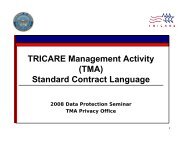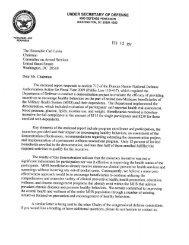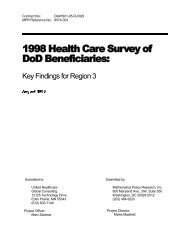Medical Management Guide, 2009, Version 3.0 - Tricare
Medical Management Guide, 2009, Version 3.0 - Tricare
Medical Management Guide, 2009, Version 3.0 - Tricare
- No tags were found...
You also want an ePaper? Increase the reach of your titles
YUMPU automatically turns print PDFs into web optimized ePapers that Google loves.
Page 82Case <strong>Management</strong> <strong>Version</strong> <strong>3.0</strong><strong>Medical</strong> <strong>Management</strong> <strong>Guide</strong>would need to be obtained for infusion therapyservices. Communication among home healthcompanies, the coordinating case manager, andthe ordering provider further serves to reconcilethe treatment plan with the service order.3. Formulation. Discharge planning can be verysimple or highly complex. It is best accomplishedusing an interdisciplinary approach to determinethe best plan for each patient. In Active Dutycases, the patient’s Command may have inputon the discharge plan.4. Implementation. The case manager will revieweach patient’s discharge plan with the patient/caregiver prior to discharge and enter theappropriate documentation in the patient’smedical record.5. Monitoring. Monitoring the quality andeffectiveness of the discharge planning processis a cumulative effort. The importance of timelyfeedback from providers, patients/caregivers,case managers, and discharge planners cannotbe overstated.Prior to discharge, the case manager mayrecommend a home assessment to anticipate allenvironmental needs in conducting a safe discharge.This is an important intervention, especially whenthe patient is coping with a severe disability thatmay involve complex mechanical assistance. Ifthe discharge is likely to be complicated, the casemanager may convene a pre-discharge planningmeeting to verify that both family members andhome care providers understand their roles, and thateveryone shares similar expectations and goals.The discharge plan should be family-centered andshould take into consideration:• Patient/family preferences.• Consideration of existing DoD/VA memorandaof understanding (MOUs).• TRICARE benefit parameters.• Qualifications for entitlement programs (e.g.,ECHO).• Previous experience with existing providers andfacilities.• Most appropriate provider/facility for thepatient.• Location of facility and providers, and theirability to meet patient/family needs.• Understanding of patient-specific goals.• The parent Command and PatientAdministration departments (if the patient is anADSM).• Impact on medical readiness and the DisabilityEvaluation System (DES) process.Barriers to effective and timely discharge planninginclude delays in completing discharge details,duplication of services, lack of patient focus, andinvolvement of available patient transport resources.Some root problems in discharge planning includelack of patient involvement/understanding of thedischarge plan, poor coordination/communicationwith the patient/family and/or caregiver(s), andpoor communication within medical providers.The patient must agree with the discharge plan tosupport maximum adherence.


